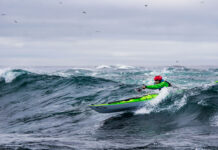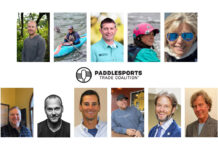Exploding popularity of SUP
Wade Blackwood
Executive Director, ACA
“We hear a lot about the exploding popularity of SUP, but I think canoeing is still the gateway drug for getting into paddlesports. That won’t change. Camps and school groups still use canoes most often, and for many kids it’s their first experience on the water. We’re also seeing more paddlers getting involved with community events and clean-ups. With social media it’s so much easier to stay connected, which is a huge benefit for the outdoor community. It’s not who you know anymore, but just being plugged-in grants new opportunities and removes barriers to getting outdoors.”
More sophisticated equipment
Wendy Grater
Owner, Black Feather Adventure Company
“More sophisticated equipment equals greater access, more challenging rivers and potentially greater risk. What I see here is that continued evolution of gear—in terms of canoe design, spray decks, drysuits, helmets, and satellite phones—has resulted in less skilled people being able to successfully access and paddle more difficult rivers. The safety net of high-tech gear and communication devices means that the consequence of a long swim may be mitigated. However, it sometimes could also mean being lulled into a false sense of security, as the real risks are still there.”
Upwards trend in canoes
Tim Miller
President, Nova Craft Canoe
“There’s been a real upwards trend in canoes, and I’m seeing the younger demographic getting into it. Over the last five or 10 years, it’s really been a 50-plus crowd and that might finally be changing. We’ve been making TuffStuff, our Innegra-basalt hull material blend, for two years now. We’re not the only company to invent a tough, new composite hull material since Royalex left the market. It’s easy to sell durability and lighter weight to canoeists, because it’s what they want. Though, I expect some hardcore whitewater people may continue to paddle only plastic hulls.”
Lighter, lighter and lighter boats
Darren Bush
Owner, Rutabaga
We see the same trend every year. Lighter, lighter and lighter boats. As Baby Boomer canoeists get older they want lighter boats. Lighter boats are also a result of people going on trips closer to home and not doing long trips anymore. The average trip length used to be 11 or 12 days. Now it’s closer to five. Big 18-footers sold well in the past, but most canoeists today are more likely to buy a 16- or 17-foot-long canoe. And if you’re tripping in a 16-foot canoe, you basically have to pack like a backpacker.”
 Watch THE CANOE an award-winning film that tells the story of Canada’s connection to water and how paddling in Ontario is enriching the lives of those who paddle there. #PaddleON.
Watch THE CANOE an award-winning film that tells the story of Canada’s connection to water and how paddling in Ontario is enriching the lives of those who paddle there. #PaddleON.








